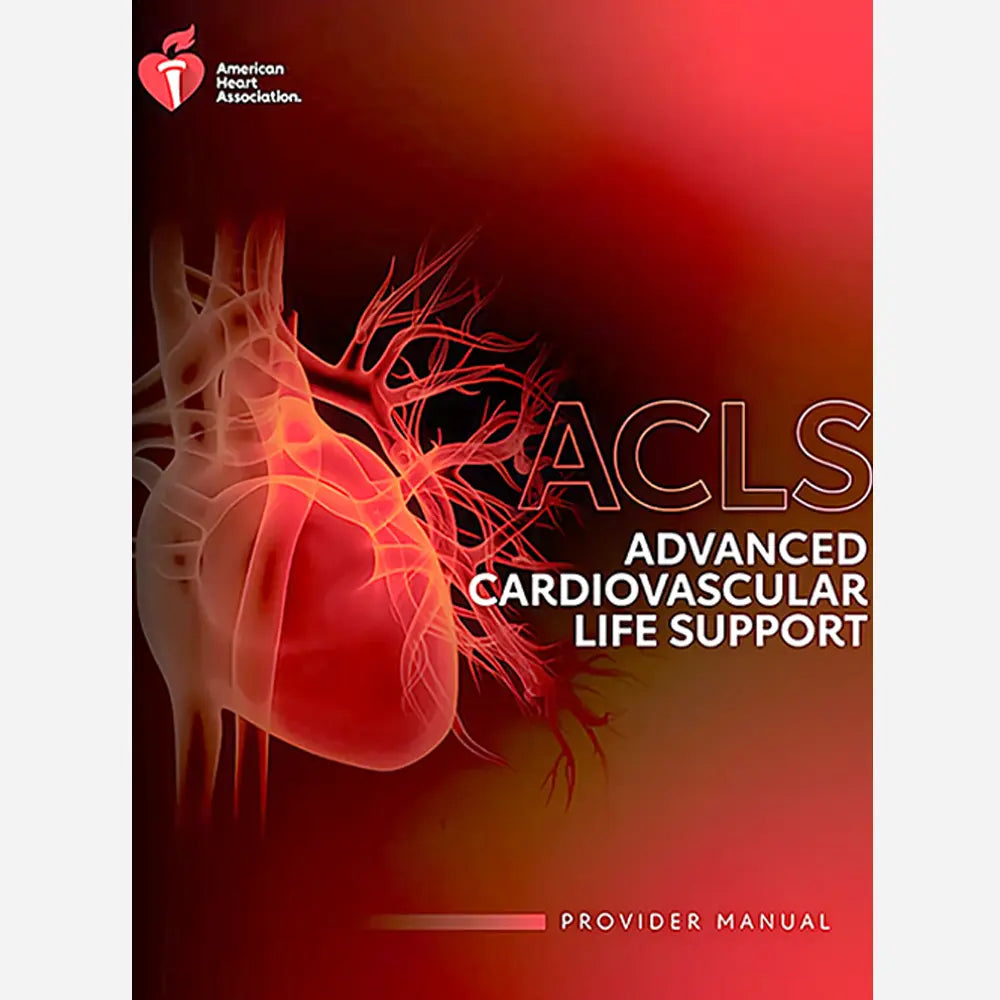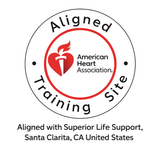Understanding the ACLS Provider Manual
All of our ACLS Provider Manual books are shipped priority, so you will get them in a timely manner before class.
- Updated to reflect new science in the 2020 American Heart Association Guidelines for CPR & ECC, as well as the 2019 Update to the 2018 ASA Ischemic Stroke Guidelines
- This course is designed for healthcare professionals who direct or manage cardiopulmonary arrest or other cardiovascular emergencies; personnel in emergency response, emergency medicine, intensive care, and critical care units; physicians, nurses, and paramedics; and others who need an ACLS course completion card for job or other requirements
- This manual includes the systematic approach to a cardiopulmonary emergency, effective team communication, and the ACLS cases and algorithms.
- Includes the ACLS Reference Card Set (#20-1120; also sold separately).
ACLS Renewal
-
Review of ACLS algorithms:
This includes the latest guidelines for managing cardiac arrest, stroke, acute coronary syndromes, and other cardiovascular emergencies. -
Recognition and treatment of life-threatening arrhythmias:
Participants learn to identify and manage various cardiac rhythms, including ventricular fibrillation, ventricular tachycardia, pulseless electrical activity, and asystole. -
Pharmacology:
Training on the administration and dosage of ACLS medications, such as epinephrine, amiodarone, and vasopressors. -
Team dynamics and communication:
Emphasis on effective teamwork, leadership, and communication skills during resuscitation scenarios. -
ACLS case scenarios:
Practical application of ACLS algorithms through simulated scenarios to enhance decision-making and critical thinking skills.
Course content:
After completing the course, students should be able to:
- Define systems of care
- Apply the BLS, Primary, and Secondary Assessments sequence for a systematic evaluation of adult patients
- Discuss how the use of a rapid response team (RRT) or medical emergency team (MET) may improve patient outcomes
- Discuss how the use of a rapid response team (RRT) or medical emergency team (MET) may improve patient outcomes
- Discuss early recognition and management of ACS, including appropriate disposition
- Discuss early recognition and management of stroke, including appropriate disposition
- Recognize bradycardias and tachycardias that may result in cardiac arrest or complicate resuscitation outcome
- Perform early management of bradycardias and tachycardias that may result in cardiac arrest or complicate resuscitation outcome
- Model effective communication as a member or leader of a high-performance team
- Recognize the impact of team dynamics on overall team performance
- Recognize respiratory arrest
- Perform early management of respiratory arrest
- Recognize cardiac arrest
- Perform prompt, high-quality BLS including prioritizing early chest compressions and integrating early automated external defibrillator (AED) use
- Perform early management of cardiac arrest until termination of resuscitation or transfer of care, including immediate post–cardiac arrest care
- Evaluate resuscitative efforts during a cardiac arrest through continuous assessment of CPR quality, monitoring the patient’s physiologic response, and delivering real-time feedback to the team
Detailed Overview of ACLS Protocols
The ACLS manual serves as a critical resource for healthcare providers, offering comprehensive guidance on advanced cardiac life support techniques. This manual outlines essential protocols that ensure quick, effective responses to cardiac emergencies. Understanding these guidelines is vital because they help save lives during critical moments when time is of the essence.
Key Components of the ACLS Manual
In the ACLS manual, you will find various sections dedicated to different aspects of care, including CPR techniques, use of defibrillators, and managing airway emergencies. Additionally, it covers the latest algorithms and protocols, so healthcare providers can effectively recognize and treat life-threatening conditions. By adhering to these updated practices, providers are better equipped to handle emergency situations successfully.
Importance of Continuous Education
The ACLS manual emphasizes the need for continuous education and practice in advanced life support skills. Lifesaving techniques evolve, and staying updated with training ensures that providers deliver the best patient care possible. Engaging regularly in workshops and refresher courses is essential, and so, providers who utilize the manual can enhance their knowledge and confidence in handling cardiac emergencies.
What is the ACLS Manual?
The ACLS manual serves as a fundamental resource for healthcare professionals who are involved in advanced cardiac life support. It provides critical guidelines, protocols, and strategies necessary for effectively responding to cardiac emergencies. Healthcare providers can depend on this manual to enhance their skills and knowledge about crucial interventions. This manual is essential for anyone looking to improve patient outcomes during life-threatening situations.
Key Features of the ACLS Manual
One of the main features of the ACLS manual is its structured approach to learning life-saving techniques. It combines clear instructions with illustrations, making it easier for users to grasp complex concepts. However, it does not just include theoretical knowledge; the manual also emphasizes hands-on practice through skills drills and scenarios. Therefore, readers can translate what they learn into action, which is vital for effective emergency response.
Importance of Regular Updates in ACLS
Because medical practices and guidelines continuously evolve, the ACLS manual is periodically updated to reflect the latest science and evidence-based practices. This ensures that healthcare providers have access to the most current information available. Additionally, these revisions help practitioners stay informed about any changes in protocols or techniques. So, regularly consulting the ACLS manual can significantly enhance the effectiveness of responses in critical situations.
What is the ACLS Provider Manual?
The ACLS Provider Manual serves as an essential resource for healthcare professionals engaged in advanced cardiovascular life support. It covers critical guidelines and the latest protocols, making it indispensable for anyone involved in emergency response. The manual is structured to enhance a provider's ability to recognize and address life-threatening conditions effectively during cardiac emergencies. Thus, mastering the information within this manual is crucial for an effective response in high-pressure scenarios.
Key Components of the Manual
This manual includes comprehensive information on various topics such as CPR techniques, use of automated external defibrillators (AEDs), and the management of specific cardiovascular emergencies. It provides step-by-step instructions along with clear illustrations to facilitate learning. Furthermore, the use of easy-to-understand language ensures that medical professionals of all levels can benefit from the content. Therefore, it not only serves as a training resource but also as a reference during actual procedures.
Importance of Continuous Learning
Engaging with the ACLS Provider Manual fosters continuous learning, which is vital in the medical field, especially in emergency care settings. Regular updates and revisions ensure that medical staff stay aligned with the latest science and protocols in ACLS. This commitment to ongoing education not only improves individual skills but also enhances overall team efficiency in emergency situations. Because of this, proficiency in the manual's guidelines is essential for anyone wishing to excel in life-saving interventions.



